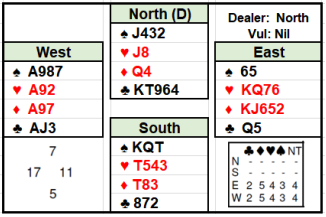Flat hand, Poor Defence
It may seem strange to pick a board to discuss that was completely flat. On this board in a club level game, every EW pair made 12 tricks playing in 3NT. Yet not one of them should have done so! Let us see why
not.

As usual let us consider the auction first. It will certainly be an EW uncontested auction. East has the first decision about whether to open 1♦ or just pass. These days many would choose to open 1♦.
Once East responds 1NT, showing 11-14 limited hand, West should be content with game. There is no obvious fit and the hands have a maximum of 31 points (normally you need about 33 for 6NT with two balanced hands).
Deep Finesse says “No trump Contracts”, should only make 10 tricks played by either East or West. That can only be achieved with a spade opening lead by either defender, which sets up 2 spade tricks to go with the ♣K. Declarer can then only make 1♠,3♥,5♦ and 1♣. Declarer will naturally start on their diamond suit and the normal way is to cash the ♦A and then lead towards the ♦KJ intending to finesse. When the ♦Q pops up from North it makes that suit nice and easy! In practice the spade bid in the auction will deter the defence from leading spades. On lead, North is more likely to lead 4 th highest club (♣6). On lead, South might try a club (♣8) or a heart? These leads should bring declarer to 11 tricks (1♠,3♥,5♦ and 2♣). Note I said just 3 heart tricks. But the reason every declarer actually made 12 tricks is they scored 4 heart tricks, because every South discarded a heart at some point. This meant East’s ♥7 scored a trick that declarer was not entitled to. Had South clung on to the ♥T543 they would have eventually scored a trick with that ♥T. How can they tell? There are two ways on this hand - count points (see advanced section for the details) and general principles. By general principles I mean two things that you simply learn through experience at the bridge table: a) Discarding from Txxx or Jxxx costs a trick an amazing proportion of the time. b) Always try to keep the same length as dummy’s suits if you can beat its lowest card in the suit. Had South followed these principles they would have discarded 2 clubs on the running of the long diamonds. Declarer will almost always then play on hearts hoping they would split 3-3. But if declarer now plays a club South should STILL cling onto that precious heart holding and discard the ♠T instead. Today had they held declarer to 11 tricks instead of 12 they would have scored a complete top! Key points to note. • Opening reasonable 11 counts with points in your longer suits is generally a good idea. • Don’t look for slam with two balanced hands unless you have about 33 points between the two hands. • Try to avoid discarding from Jxxx or Txxx. It costs a trick a large proportion of the time. • Try to keep the same suit length as dummy if you can beat its lowest card in a suit. When declarer has opened or rebid NT, you can work out the points partner will have to within a fairly narrow range. That can often help you in defence.
- Log in to post comments






Alerting 2S after a 2D transfer
testing the comment